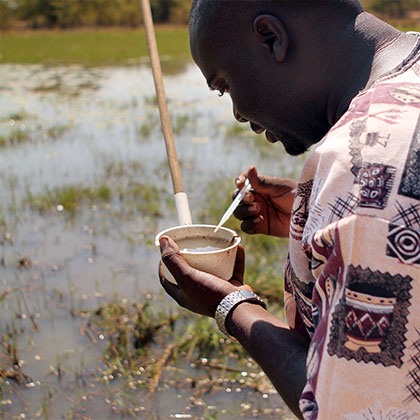Vector Control and Entomological Surveillance for Malaria Elimination

The MEI’s current portfolio of work in vector control and entomological surveillance covers the following areas:
Malaria is a vector-borne disease transmitted by the female Anopheles mosquito. Consequently, vector control and entomological surveillance are cornerstones of any malaria control or elimination program. Vector control for malaria commonly refers to two core interventions: insecticide-treated nets (ITNs) and indoor residual spraying (IRS) with insecticide, although in some settings these may be supplemented with larval source management or personal protection measures (e.g., topical skin repellant). ITNs and IRS have been demonstrated to be highly effective in reducing and interrupting malaria transmission when coverage is high; ITNs alone are responsible for an estimated 68% of the 663 million malaria cases averted globally between 2000 and 2015.1 Yet widespread insecticide resistance, changing vector bionomics (e.g., preference for outdoor biting), and suboptimal intervention coverage threaten the future success and sustainability of ITNs and IRS. In some settings despite high or universal coverage with ITNs and/or IRS, residual malaria transmission still persists, requiring additional or more appropriate interventions to target the remaining human-vector contact points (i.e. gaps in protection) and eliminate malaria. New cost-effective vector control tools and approaches are urgently needed to target residual transmission and outdoor-biting mosquitoes to advance the fight against malaria.
Entomological surveillance is critical to informing an effective vector control strategy, guiding tool selection, and identifying potential limitations such as insecticide resistance or residual transmission. Entomological surveillance refers to the collection of entomological data over space and time and is essential for understanding vector species, specific population dynamics, and behavioral traits that affect disease transmission and intervention effectiveness over time. Entomological surveillance data combined with human behavior data (to determine time and place of human-vector exposures) can be used to identify gaps in protection and local drivers of transmission to guide decision-making on intervention selection, targeting, and tailoring. Capacity to collect, process, interpret, and take action on entomological data at national and subnational levels is critical to designing, implementing, monitoring, and evaluating an effective vector control strategy to reduce and eliminate malaria.
1 Bhatt S, Weiss DJ, Cameron E, Bisanzio D, Mappin B, Dalrymple U, et al. The effect of malaria control on Plasmodium falciparum in Africa between 2000 and 2015. Nature. 2015; 526:207–11. DOI External Link PubMed External Link